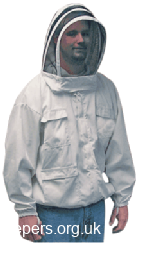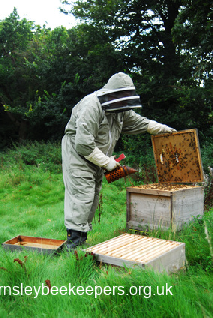Beekeepers wear special clothing to protect from being stung. Although a small proportion of beekeepers choose not to wear any protective clothing, most opt for some form of protective clothing of some kind.
The beginner should never contemplate keeping bees without wear protective clothing. In the early stages of the craft, it is important to build confidence. Knowing that you are unlikely to be stung allows you to concentrate your mind on the task in hand. No one like being stung......even for the hardy beekeeper who has been stung many times before, it hurts!
Some believe that by being repeatedly stung over a long period of time, you can build up a level of tolerance to bee venom to the point where no or little reaction (and pain) occur. This may work for some, but for others can lead to an increase in sensitivity and ultimately, allergy. Therefore, avoiding being stung is probably the safest (and most comfortable) option (more on stings).
Types of Protective Clothing
There is a wide choice of protective clothing available and from lost of different sources (from mainstream retailers like Thornes to ebay). Visiting a retail shop gives the opportunity to try clothing out for size, but you will pay more. Ebay and many of the online sellers will offer a wide choice at much lower prices, but you won’t be able to try anything before you buy. You pay your money, you take your choice!.
Face Protection
All sensible beekeepers should -

Upper Body Protection
A bee jacket is used by many to provide protection to head, arms and upper body. The jacket (worn with gloves) is a good way of keeping bees out. A jacket typically has a hat and veil built in. Better jackets will allow the hat and veil to be unzipped (to uncover the head or remove the hat). Average bees (not particularly aggressive but not totally docile) will be largely kept at bay by a bee jacket. Very active and aggressive bees will occasionally still find their way in (ruffles in the jacket or clothing may allow gaps between the elasticated waste band and the clothing beneath). Bee jackets can be worn with separate trousers, providing an additional layer to prevent bees stinging through ordinary trousers or jeans.
Full Body Protection
Best protection of all is given by a full length bee suit (worn with gloves and boots). They are the most expensive, but will help build confidence and almost rule out being stung if worn with adequate gloves and boots.

Gloves
Always a matter for debate -
The best gloves to wear are typically those with elasticated gauntlets (arm protectors). Gloves are usually made of soft leather or PVC coated fabric.
Boots
It is often advisable to wear boots such as wellingtons or walking boots that allow the trousers to be tucked in. Bees have a tendency to “go for” the ankles, particularly when dark socks are worn. Also, crawling bees tend to go up rather than down, so covering the bottom of trouser legs is recommended. Ankle guards can also be purchased which simply pull over the shoe and trouser bottoms to stop any unwanted visitors from climbing up the inside of trousers (!).

